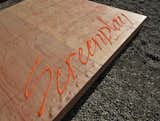The Making of Screenplay: Part 5
For this project, we know that we have to build twenty-five custom-steel "profiles", with each piece being slightly different due to the variations that we are trying to achieve in the elevation and section of the project. There are several major challenges in building the steel frame profiles. First: How do we build each steel profiles so that they are completely flat and planar? Second: How do we cut every angle of the steel quickly and accurately without using a protractor to measure the angle of each cut every time? While simple in concept, the realities of achieving this in three-dimensional space are easier said than done. Our solution is quite simple—we decided to build absolutely as much as possible on a flat surface. So, we built a platform.
The platform is not only our workspace, it is also our leveled surface, measuring and alignment tool, cutting mat, elevated shelter to store steel pieces below, and a colorful addition to our office backyard. The platform is built of simple 2' x 6' wood studs and plywood sheathing. We leveled the platform so that we have a large, flat surface to cut and weld on. If you start with a small, uneven surface, you are making the job exponentially more difficult, especially when you have a team of people working on it. For the graphics on the platform, we painted a grid system on top of the platform to facilitate the aligning, cutting and welding process. Since we had designed the intersection of each steel piece to align with a grid point, we can quickly layout the steel tubes on the grid, marking where their intersections occur, and cutting precisely to the correct angles.
One thing to note is that simultaneous to the building of the platform, our staff is outputting steel profiles from our digital model into 2D fabrication drawings so that once we are in the field it is clear how each steel frame sits on the grid. Concurrently, we are also checking each profile with the ongoing physical model to ensure that we have allowed enough space in all areas of the steel to allow the rope to pass through. While we have carefully built into this process feedback loops to ensure the least amount of errors, we do expect to rework some of the steel pieces once we start stringing the rope on the frame.
Next week we start building the steel profiles, and we’ll see how well our platform actually serves its purpose!
Published
Last Updated
Get the Dwell Newsletter
Be the first to see our latest home tours, design news, and more.






